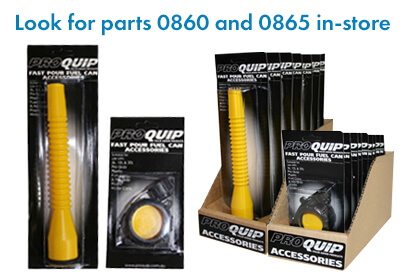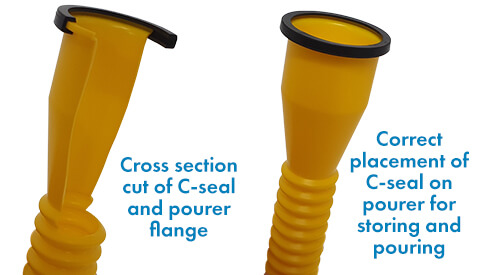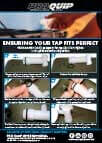How long can I store drinking water in a Plastic Can?
Can I store Pro Quip Plastic Fuel Cans on their side?
Whilst our Cans are tested and pass Drop Tests, Hydraulic Pressure Tests and do not leak as the “Closures must be so designed that they will remain secure and leak-proof under normal conditions of transport”, the “normal conditions of transport” state that our plastic containers with a vent closure should be stowed and restrained with the closure uppermost (ADG Code Section 8.1.2.7), therefore, upright. The bayonet closure of our Steel cans allows them to be transported in any orientation.
Tap supplied with your Pro Quip Heavy Duty Water Can is not fitting correctly
If you have found the tap supplied with your Pro Quip Heavy Duty Water Can is not fitting correctly into the thread on the can, then we have the solution.
The most likely cause may be the seal interfering with the thread before it gets round to its correct position facing downwards. The solution is to rotate the seal found on the tap so that it forms a taper towards the thread on the tap. The seal can be removed carefully by rolling with your thumb and using a blunt edge (like a flat head screw driver or butter knife) to pry the seal from its seated position. Now place the seal so that the section that was facing outwards from the tap is now facing the plastic flange (towards the spigot rather than the thread of the tap) and re-seat the seal.
The seal should now taper towards the thread of the tap which will stop it from interfering with the container thread at the wrong position. Thread the tap back into position and you should find it now ends at the correct 6 o’clock position and sits firm for use with a single hand.
We have now made a small modification to the tooling to better allow the variations found in the seal, and ensure a perfect experience with the tap for every Heavy Duty Water Can we make.
Remember, if you have any problems or concerns at all with our products, you are encouraged to lets us know by calling or contacting us through the website contact information page. As a proud Australian company with Australian made products, we are always looking to improve and your consumer feedback is very important.
Ensuring Your Tap Fits Perfect
Storing your Water Can when it’s not in use
The best way to store a Water Can is completely dry. Once you have finished using the can, give it a rinse with warm water and bicarb soda. For general purpose cleaning the ratio is normally 1 tablespoon per 500ml. Shake the solution around the inside of the can to ensure it reaches all areas and leave it to sit with the caps in place but loose for a minimum of 30 minutes. Pour out the solution then rinse again with water and leave it to dry upside down with all caps open in a well ventilated area. It may take some time to dry properly however you can speed up the process with paper towel on the end of rod of some sort to reach the corners of the Can. The bicarb will help prevent mould growth and remove and smells that arise from any leftover water that was left in the can.
When the can is completely dry on the inside, you can store it with the caps closed finger tight. You may find that ambient temperature changes will allow the can to expand and contract should there be any extreme differences during the night or day. This is a natural property of HDPE plastic and is far more pronounced when fuel is stored. The tooling and manufacture process we use for our Water Cans is the same as those that go into producing our Fuel Cans, so the structure of the Can will easily handle these expansion changes. Fortunately all of our Waters Cans are produced with the breather cap on the back which can be slightly loosened to allow equalisation of pressure while limiting the potential exposure of the inside of the can to external contaminants.
Should I filter my fuel when pouring from a Fuel Can?
We recommend always filtering fuel when pouring from a Fuel Can to limit the potential for any contaminants from reaching your fuel tank.
Plastic or Metal Jerry Can, which should I choose?
There are benefits to both types, and some important points to consider based on what you plan to do with them.
Plastic cans offer great scratch resistance and can be used in general fuel storage and marine applications due to the HDPE plastic construction. Plastic cans are lighter than steel though don’t let that fool you; when filled to nominal capacity the 20L versions still weigh over 16kg with Unleaded and over 18kg with Diesel. Check out the Pro Quip Fuel Can Select System further weight and pouring information of other options in the range. Plastic cans are also cheaper to purchase while also including a pourer, however the Australian Dangerous Goods Code recommends that HDPE fuel containers be replaced after 5 years of use. Plastic cans should always be stored upright and secured during travel. HDPE plastic will always swell and contract from changes in ambient temperature if their pressure hasn’t been manually equalised with the vent cap which can make them more difficult to remove from holders.
Pro Quip Metal Jerry Cans offer a longer term option with well looked after cans lasting over 20 years (from personal experience). The internal fuel resistant enamel prevents internal rust from condensation. Both Super Cans and Traditional Style Jerry Cans are able to be stored in any orientation which is easier for travel. The weight when full of a Pro Quip Metal Jerry Can will be 19kg for Unleaded and 21kg for Diesel. If lifting weight is an issue but metal is still the preference, consider smaller sizes such as the 10L and 5L variations. There is very little noticeable expansion and contraction due to changes in ambient temperature with Pro Quip Metal Jerry Cans due to the 0.9mm Steel used.
Can I use Unleaded Fuel in Diesel Cans and vice versa?
The colour of Pro Quip Plastic and Metal Jerry Cans is for identification purposes only. There is no difference in the plastic used in the plastic versions, or the enamel used in the metal versions between colours.
Do 20L Pro Quip Plastic Fuel and Water Cans fit holders?
Yes, the upright design of both 15L and 20L Pro Quip Plastic Fuel and Water Cans are suitable for traditional jerry can holders that fit metal varieties. The Can Caddy Fuel Can Transport Tray and stabilisers can be used for Pro Quip 5 and 10L Plastic and Metal Jerry Cans.
Can I buy replacement parts for my Pro Quip Can?
All replacement parts are available either directly through Pro Quip or at one of the leading retailers who stock our products on an everyday basis. Click on the particular part you need to find out where, or alternatively get in touch with us directly. Please bear in mind that not all stores in some retail chains will stock every product in our range.

My Pro Quip Plastic Fuel Can is leaking when being poured or stored, why?
The most common cause of a Pro Quip Plastic Fuel Can leaking when being stored or poured is because the seal is not seated in its correct position. The “C” Seal is used to allow components to be stored inside the can during transport and storage. This seal should always be positioned over the flange or shoulder of the pourer, allowing it to seal against the neck of the can and the cap (when pouring) or stopper (when storing). Check out our “How to” section in the Info Hub for the proper assembly of these parts.

How tight do I need to close the components on my fuel can?
Components should only be closed to finger tightness. This decreases the chance of compressing, pinching or tearing the seal underneath which can cause a leak.

